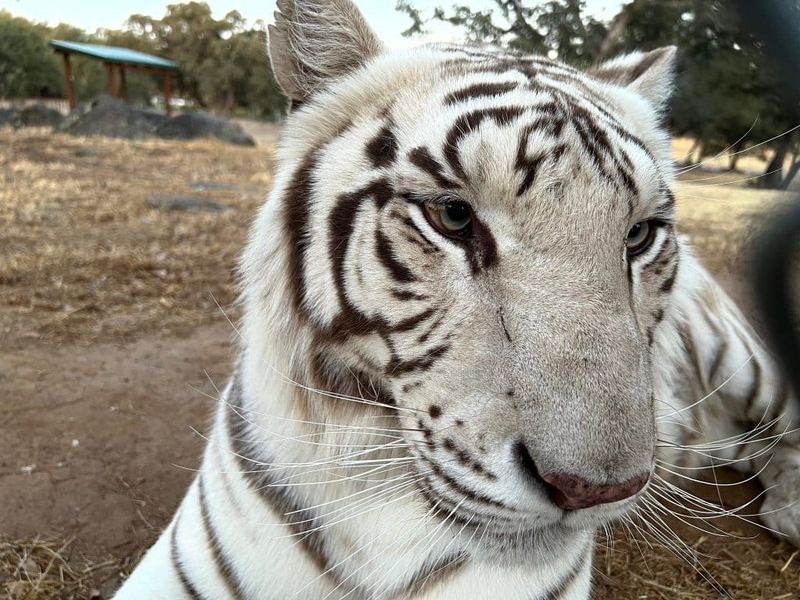📖 Table of Content:
- 1. No Two Tigers Share the Same Stripe Pattern
- 2. Tigers Can Leap Over 20 Feet in a Single Bound
- 3. A Tiger’s Roar Can Be Heard From Two Miles Away
- 4. Female Tigers Raise Cubs Entirely Alone
- 5. Tigers Have the Largest Canine Teeth of Any Land Predator
- 6. White Tigers Result From a Rare Genetic Mutation
- 7. Tigers Have Nearly 30 Subspecies Extinct in the Last Century
Tigers, the largest and most awe-inspiring members of the cat family, have long fascinated people around the world. Their bold stripes and muscular build make them instantly recognizable and evoke a sense of both admiration and respect. Yet despite their formidable presence, these incredible predators are facing grave threats in the wild.
With fewer than 4,000 tigers left in the wild, their survival is hanging by a thread. Habitat destruction, poaching, and human-wildlife conflict continue to push these majestic creatures closer to the brink of extinction. These challenges demand immediate attention to ensure that future generations can experience the beauty and power of tigers.
Efforts to conserve tigers are more critical than ever, as their continued existence in the wild plays a vital role in maintaining the balance of ecosystems. Understanding the threats they face and the steps being taken to protect them fosters a deeper appreciation for these incredible animals. Every action, no matter how small, can contribute to their preservation and survival.
1. No Two Tigers Share the Same Stripe Pattern
Just like human fingerprints, each tiger’s stripe pattern is completely unique. Scientists use these distinctive markings to identify individual tigers in the wild without disturbing them.
This natural identification system helps researchers track population numbers and movement patterns across territories spanning several miles. Some tigers have over 100 stripes decorating their orange coats.
The pattern serves as perfect camouflage in tall grasses and forests, allowing these powerful hunters to stalk prey undetected. Even more fascinating, the stripes aren’t just in their fur—they’re also present on their skin underneath!
2. Tigers Can Leap Over 20 Feet in a Single Bound
Athletic prowess defines these apex predators. Tigers can launch themselves forward more than 20 feet in a single jump—roughly the length of a large SUV. Their powerful hind legs provide extraordinary strength for these impressive leaps.
When hunting, this ability allows them to close the distance with prey in an explosive burst. Tigers combine this jumping ability with remarkable speed, capable of short sprints reaching 40-50 mph.
Most surprising to many cat lovers is that tigers enjoy water, unlike their domestic cousins. They’re excellent swimmers who often soak in rivers and lakes to cool off during hot weather or while pursuing prey across waterways.
3. A Tiger’s Roar Can Be Heard From Two Miles Away
The bone-chilling roar of a tiger carries across the forest for up to two miles. This impressive vocal range comes from a specialized ligament in their throat that other big cats like lions also possess.
Tigers use these thunderous calls to announce territory and avoid physical confrontations with rivals. The sound is so powerful it can literally paralyze prey animals with fear.
Beyond roaring, tigers communicate through an array of vocalizations including chuffs, growls, and snarls. The friendly “chuff” sound—a low-frequency snort—signals contentment or greeting between tigers who know each other well, similar to a house cat’s purr.
4. Female Tigers Raise Cubs Entirely Alone
Single motherhood is the norm in tiger society. Female tigers handle all parenting responsibilities without any help from male tigers, who play no role in raising young.
A typical litter consists of 2-4 cubs that stay with mom for about two years learning essential hunting skills. During this time, the mother must hunt enough to feed herself and her growing offspring while protecting them from threats.
Cubs are born blind and helpless, weighing just 2-3 pounds. The survival rate in the wild is sadly low—only about half of all tiger cubs survive to independence. Those early years represent a vulnerable time when mothers must be especially vigilant against threats from other predators and rival male tigers.
5. Tigers Have the Largest Canine Teeth of Any Land Predator
Measuring up to 3 inches long, tiger canines outsize those of all other land carnivores. These impressive teeth can penetrate deep into prey, allowing tigers to take down animals much larger than themselves.
The bite force behind these teeth is equally remarkable—approximately 1,050 pounds per square inch. For comparison, that’s about twice the bite force of a lion and more than ten times stronger than a human’s bite.
Tigers use these formidable weapons to deliver a killing bite to the neck or throat of their prey. Their hunting technique typically involves stalking silently to within pouncing distance, then using their incredible strength and these powerful teeth to bring down prey quickly and efficiently.
6. White Tigers Result From a Rare Genetic Mutation
The stunning white coat that captivates so many tiger admirers comes from a recessive gene affecting pigmentation. True white tigers are not albinos—they have blue eyes and black stripes against their white fur.
This genetic variation occurs naturally in about 1 in 10,000 births in the wild. Today, virtually all white tigers exist in captivity, where they’ve been selectively bred for this trait.
Unfortunately, this selective breeding has led to numerous health problems including crossed eyes, cleft palates, and immune deficiencies. Many reputable zoos and conservation organizations now discourage breeding white tigers since it offers no benefit to tiger conservation and often results in animals with significant health challenges.
7. Tigers Have Nearly 30 Subspecies Extinct in the Last Century
The alarming rate of tiger extinction represents one of conservation’s greatest tragedies. Of the nine subspecies that existed in the early 1900s, three have completely disappeared: the Bali, Javan, and Caspian tigers.
Habitat loss stands as the primary threat, with over 93% of historical tiger territories now gone. Poaching for traditional medicine markets continues despite international bans, further threatening remaining populations.
The South China tiger hasn’t been spotted in the wild for over 25 years and likely exists only in captivity now. Conservation efforts focus on the six remaining subspecies: Bengal, Indochinese, Malayan, Siberian, South China, and Sumatran tigers—all classified as endangered or critically endangered by international wildlife organizations.







